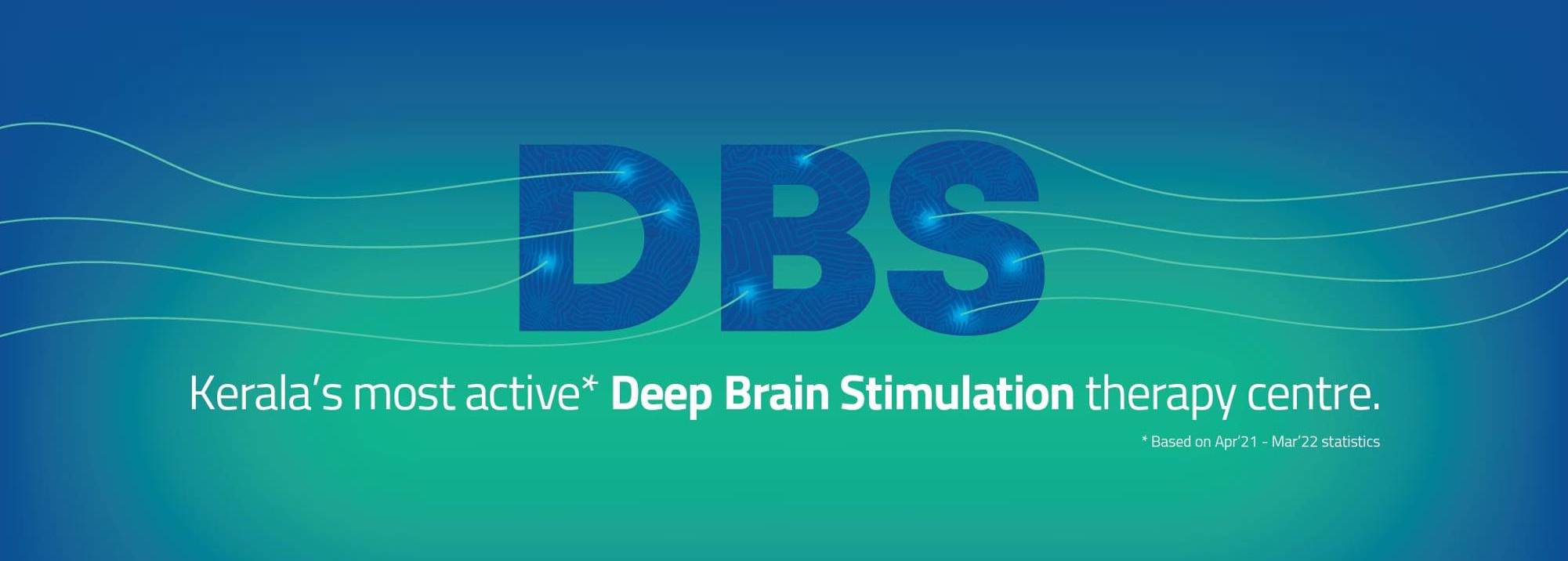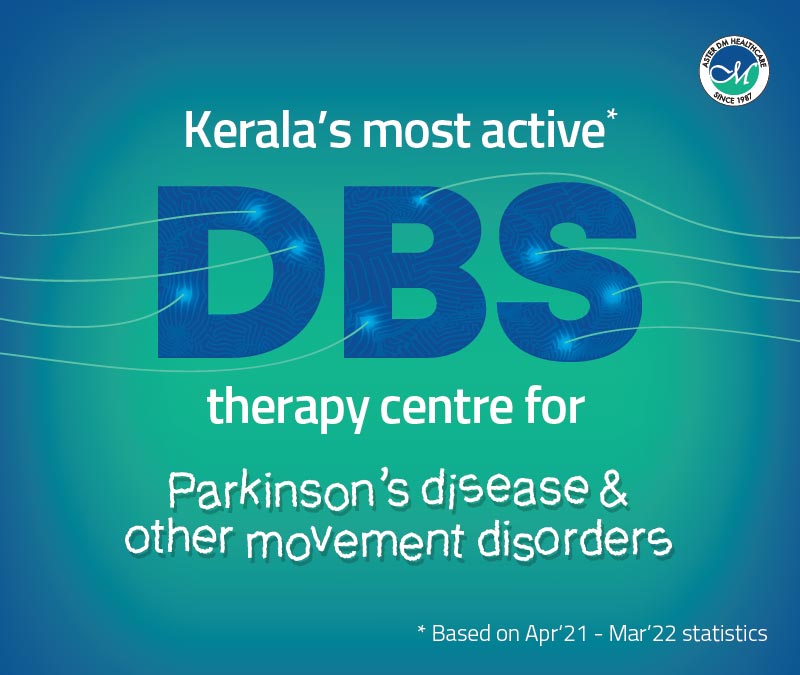Aster Centre for Parkinson's and Movement Disorders
Movement disorders are a group of diseases affecting the ability to produce and control body movement. Lakhs of people in India lives with movement disorders, including Parkinson's disease. It is the second commonest neruological degenerative disease of the brain after Alzheimer’s disease. Estimates show that 1-2% of people over the age of 60 years develop this condition.
At the Aster Centre for Parkinson's and Movement Disorders in Aster Medcity Kochi, our mission is to offer holistic approach for Parkinson's disease and different types of movement disorders. We take pride in our empathetic, compassionate, timely, and inclusive approach to care for patients with ataxia, dystonia, essential tremor, Lewy body dementia, Parkinson's disease, Parkinsonian syndromes, restless leg syndrome, tic and Tourette syndrome, chorea, spasticity and tardive dyskinesia, and other movement disorders.
Touted to be comprensive centre, we provide the most advanced forms of medical and surgical care and support services to patients afflicted with various movement disorders and their caregivers. Our team comprises of Movement Disorder specialist, neurologist (adult and paediatric), cognitive neurologist, functional neurosurgeons, physiatrist, psychologist, psychiatrist, neuroradiologist, and pain & palliative care doctors. The team is not only specially trained in the diagnosis and treatment of movement disorders, but also actively involves in clinical research to further strengthen our understanding of these complex neurological degenerative diseases.
Together with you and your family, our nationally and internationally recognized experts in the field of movement disorders will work to build a complete picture of your disorder, help you to understand, and customize the treatment plan that works best for you.
Message from the program director
We trained in nervous system conditions , brain and nervous system surgery, and other areas work together to determine the most appropriate treatment for your condition.
We run a number of Specialty Clinics at Aster Medcity. Each clinic runs on a particular day of the week and offers a gamut of services to the needy patients. Our services include, but not limited to:
- Clinical evaluation ,diagnosis and medical treatment of Adult and pediatric Movement Disorders
- Selection of cases of Movement Disorders for DBS treatment
- Selection for Apomorphine pump treatment for advanced Parkinson’s disease (OP assessement of eligibility and IP for initial titration). Indicated for those who opt for non surgical treatment or in whom surgery is contraindicated
- Cognitive and Neuropsychological evaluation
- Neuropsychiatric assessment
- Physiatry assessment and physiotherapy
- Autonomic function tests
- Sleep studies
- TRODAC studies, MRI through Radiology and nuclear medicine dept
- Speech, swallowing and gait rehabilitation
- Pain and palliation in advanced movement disorders
- Selection for intrajeunal/duodenal infusion (PEG) of duodopa when it becomes available in India or imported by patients with advanced PD who are not suitable for DBS
- Selection of patients for clinical trial and research
- Movement Disorder Clinic
- Deep Brain Stimulation (DBS) Programming Clinic
- Botulinum Toxin Clinic
- Pediatric Movement Disorder Clinic
- Memory Clinic
- Deep Brain Stimulation (DBS) surgery : For Parkinson’s Disease, Essential Tremor, Dystonia ( primary and selected secondary dystonias), intractable Tourettes Syndrome)
- Focussed ultrasound therapy : for Essential Tremor (if FUS is set up in COE Neurosciences under brain tumour centre)
Evaluation and treatment of acute and chronic movement disorders
Patient Testimonials
A movement disorder is a condition that arises in the brain and causes unwanted, excessive movements or results in a loss of ability to move as much as a normal person or move with normal speed. The different abnormal movements are shaking (tremor), stiffness of muscles, slowness and loss of balance (parkinsonism), twisted postures (dystonia) abrupt jerks (myoclonus), dance-like flowing movements (chorea) and stereotyped rapid jerks and involuntary sounds (tics). Many diseases that produce movement disorders.
DBS is a recommended treatment for Parkinson’s disease, Essential Tremor and Primary generalized dystonias. It has also shown success in some forms of secondary dystonias and Tourette syndrome, when these diseases are not well controlled by drugs alone. The most common condition for which DBS is used is Parkinson's disease (PD).
PD is not curable. PD is initially treated with medicines that relieve the symptoms and enable them to function well. Medicines give excellent relief the first 3-5 years of treatment. With the progression of the disease and changes in the brain, the beneficial effects of levodopa wane and symptoms of patients fluctuate through the day. Drugs can also induce dyskinesias which appear as involuntary dance -like flowing movements in the neck, trunk, or limbs. These complications occur in most, if not all patients during the course of the disease, usually within 5-10 years.
- Individual patient outcomes depend on several factors, including age, patient selection, target selection for implantation, accuracy of electrode location, programming settings, adjustments in medicines following DBS.
- Symptoms of PD that improve with levodopa, improve after DBS.
- Partial or incomplete response to DBS in PD patients may be partly due to incorrect patient selection or suboptimal DBS electrode placement.
- Unrealistic expectations from DBS can also result in patients being dissatisfied with the treatment.
- A critical factor influencing successful outcomes for DBS is a multidisciplinary team that specializes in the care of patients implanted with DBS devices. The typical team includes a movement disorder specialist, a neurosurgeon who has a specialty training in stereotactic and functional neurosurgery and a neuropsychologist who has knowledge and experience assessing cognitive, mood and behavioural changes in PD. Patient outcomes are better when DBS surgeries are performed regularly by the team in high volume centres.
- Device programming and management of medications following DBS are better when provided by an experienced movement disorder specialist.
These are potential risks for DBS surgery, though low (1-2%), of complications during the implantation (bleeding in the brain causing stroke, infection, malposition of electrodes, or unsatisfactory trajectories and abandonment of procedure) or during long-term care (hardware failure, extension cable breakages). Spread of current to neighbouring structures can produce unwanted effects such as diplopia, slurring of speech etc which are reversible on reducing the current but may indicate that electrode is not in motor area within the target.
The life of a non-rechargeable or fixed life battery (IPG) is approximately 3-5 years (depends on individual patient’s current usage) and will need to be replaced, while the rechargeable ones can last 15-25 years and therefore fewer replacement surgeries. Rechargeable batteries require daily or weekly recharging. Some patients prefer regular recharging for the advantage of fewer battery replacements while others prefer 5 yearly battery replacement to regular recharging. Rechargeable batters are almost twice as expensive as the non-rechargeable ones.
DBS involves delivering small amounts of electricity via 2 thin electrodes (one on each side of the brain) which are introduced through 2 small holes in the skull and implanted into a specific target area deep in the brain. This procedure called stereotactic neurosurgery.The source of the electric current delivered, is a sophisticated pacemaker-like device (implantable pulse generator or IPG) implanted under the skin of the chest, below the collar bone. The IPG is connected to the two electrodes within the brain through an extension cable passing under the skin of the neck and behind the ear. Several software packages are available to plan electrode targets and trajectories on brain MRI of the person. The accuracy of targeting is confirmed prior to implantation of the DBS electrode by the movement disorder specialist, first by recording characteristic firing patterns of brain cells in the target area using a procedure called microelectrode recording. This is followed by a test stimulation to assess the benefits or any unwanted effects of electrical stimulation in that location. Once the location is confirmed, the DBS electrode is implanted in the same spot. In the days to weeks following DBS surgery, the movement disorder specialist will select the appropriate current settings in the implanted IPG that will provide the best clinical benefits to the patient. This procedure is called programming. It may need a few programming sessions in the first 3-6 months to identify the best stimulation settings for an individual. Thereafter clinic visits can be annual, to check battery settings, battery life and for adjustment of drugs.
PD is a progressive neurological disease caused by degeneration of nerve cells in an area in the brain called the substantia nigra. It is a part of the basal ganglia circuit that controls movements. The cells in substantia nigra produces an important chemical called dopamine required for the normal functions of the basal ganglia circuits. Parkinson's disease patients experience the typical motor symptoms of tremor at rest, stiffness of the limbs, slowness of all activities and later poor balance in varying combinations. It is estimated that about 7-10 million people have the disease world -wide and about 60,000 new cases are diagnosed each year. While the risk of a PD increases with age (average age of onset in the early 60s), around 5-10 percent develop the symptoms before the age of 50 and about 5% have other family members affected by the same condition.
DBS in PD is recommended for patients (1) experiencing motor symptoms fluctuations with or without dyskinesias (2) tremor unresponsive to drugs and (3) who cannot tolerate high doses of drugs. Recent studies have shown that patients with mild to moderate fluctuations or dyskinesias benefit as much as those with more advanced disease and early referral is indicated. Long-term results of DBS have shown significant improvement in (1) the motor symptoms of PD (2) the ability to perform activities of daily living independently and (3) the quality of life of patients.
Previous reports show that motor function was significantly improved after STN DBS, by 25–60% in the “off” medication state after STN DBS, patients were able to reduce dosages of dopamine replacement medications by approximately 50%. Non-motor symptoms of PD did not improve among patients treated with STN DBS. Several studies have assessed the long-term efficacy at 5-year and 10-year time points after DBS. These studies indicate that STN DBS has continued positive benefits and persisting improvement in motor scores and in quality-of-life assessments.
Proper selection of patients is critical to success. This requires careful evaluation by a movement disorder neurologist, a neurosurgeon, a neuropsychologist, and a psychiatrist if needed. DBS is not for every PD patient and not for patients in the very advanced stage of the disease.
- The most suitable candidates are those with motor fluctuations and/or dyskinesias or those with tremor that does not respond satisfactorily to levodopa.
- The cognitive, psychiatric, and behavioural status must be normal or only minimally affected. Patients with dementia (severe cognitive disturbance) and severe depression are not offered DBS.
- Patients should have no other serious medical conditions.
- There are no strict age limits for DBS. The ideal profile is age less than 70 years at the time of surgery. Recent reports show that patients older than 70 years have no increased surgical complications and can benefit from DBS.
- Patient expectations, cooperation, and familial support are important considerations while selecting patients for DBS.
Patients who are at increased risk of perioperative complications should be optimized on medicines before surgery is planned.
- Persons with a history of heart disease should be evaluated by a cardiologist and those taking antiplatelet drugs for heart disease or anticoagulants must temporarily stop taking these medications prior to surgery or bridged with short acting anticoagulants.
- Hypertension and diabetes should be adequately controlled.
- Depression, impulse control disorders and anxiety to be treated before surgery.
- Appropriate counselling of the patient and family.

